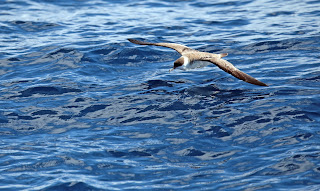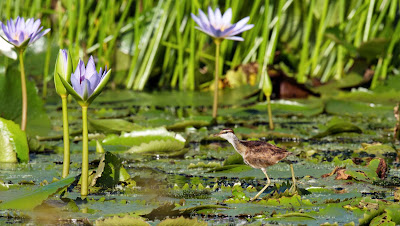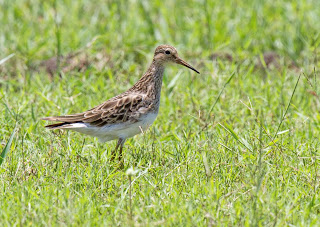 |
| Atlantic Yellow-nosed Albatross |
Anxiety & anticipation dominate our emotions, as always, the minute we board the Zest II; ex-Simon's Town
en route the fishing grounds, some 25 miles SSW of Cape Point.
Alisha suffers from chronic seasickness; medicated, sedated or otherwise. Anticipating the dry-heaves is reason enough to make anyone anxious. I have no such qualms but I do, however, anxiously anticipate the day's
catch...
To begin with, some formalities. A
pelagos cruise operated by
Zest for Birds on-board Captain Harry’s decommissioned ex-navy boat, the
Zest II, is by far and away the best functioning outfit and for one simple reason only. Bigger is better and here we’re not talking egos either; we’re talking boats.
 |
| Atlantic Yellow-nosed Albatross |
Foreign birders ie:
anybody not from Cape Town who fly south for the sole purposes of a pelagic cruise will more often than not be met with disappointment on any other
'small-boat' outfit. On any given day the swells can be impressive! Perversely, the bigger the seas the more adverse the weather and the better the birding!
Not much younger nor more aesthetically appealing than the
Zest II herself, with apologies to the boat, Messrs T. Hardaker, J. Graham, B. Rose, Cpt. Harry and 1st & only mate 'Chief', are constant fixtures on board. These gentlemen are to sea-birding what Shakespeare was to verbosity; simply world-class. Picking out
Indian from
Atlantic or
Wilson's from
European is, if anything, second-nature. Any pelagic adventure without this team is akin to a shark-cage in a sardine-can; a touch absurd...
Lest we get all
zesty and before I accept their PR appointment, let me say this. The
Zest II was not decommissioned because she blitzed across the seas.. Neither was she procured into life-long splendour and aggrandisement. She floats and that's all there is to say except perhaps to lament time lost getting to & from the
pelagically-sweet-waters some 25 miles out to sea. You'll spend 7 hours just getting there & back.. Granted the likelihood for views of rare & interesting cetaceans
en route are not to be scoffed at. That said and in fairness to the tub, if power is defined by the number of horses in the string, I suspect Cpt. Harry leaves most in the stable..
The formalities complete what about the birding itself? Two words;
Bloody Brilliant!
 |
| Long-tailed Jaegar (Skua) |
19 species in total; 5 Shearwaters, 4 Skuas, 4 Albatross, 2 Storm Petrels, 3 Petrels & a specialist gull. Amazingly two were lifers; Long-tailed Jaegar and Manx Shearwater. Flesh-footed Shearwater was also a surprise, confined more usually, to waters further east. Bird numbers, as is always the case in summer, were low. The species count however, as is always the case in summer, was high!
Anybody who has been on a
pelagos and who is, like me, a keen amateur photographer, will know the frustration a pelagic guarantees the shooter in post-production. I doff my hat to the more accomplished photographers on-board who secured the shots more consistently.
First off, store the gimbal & tri-pod at the hotel or take them along as a coat-hanger when the frustration has you hot under the collar. The vagaries of
pitch & roll interspersed with the downwind air-speeds of those which shear across the water, makes composition akin to the accuracies usually associated with kindergarten's '
pin-the-tail-on-the donkey..' Shooting the birds floating on the water is about as photographically appealing as the Premier in her curlers. Where water joins sky light metering is a guess at best. Wholly brown or black birds require a stop or two up whilst the more prominently-white require a full stop or two down... Accurately metering the inconsistent light, adjusting the compensation, picking out the target from its peers of hundreds, adjusting composition for pitch, roll & airspeed, all in the 3 seconds or so the bird is in effective range, makes for imaginative cursing!
A gallery of Curses
 |
| Wingless - an albatrussed without Red Bull.. |
 |
| Circumcised at the wing - eligible for the para's. |
 |
| 1.5 nano-seconds too soon - too far / so near! |
 |
| As appealing as Her Worship in Sunday slippers |
 |
| Under-compensated - dark as the Dark Knight in a mood |
 |
| Over-exposed - just one small stop... is enough! |
 |
| Exit top right - Stage-fright? |
 |
| Come back...! Please. |
 |
| Swing through it son ... |
By & large I had a cracker day. I can't say the same for Alisha who clung to the stern railing for the duration of the trip...
Back on dry land Alisha's first words were not entirely unexpected and in the interests of our younger readers I'll paraphrase - '
This trip is for the birds!' which coincidentally were my thoughts exactly. This trip is only for the birds and long may they skim the wave-tops. Total for the year to date - 522.



































